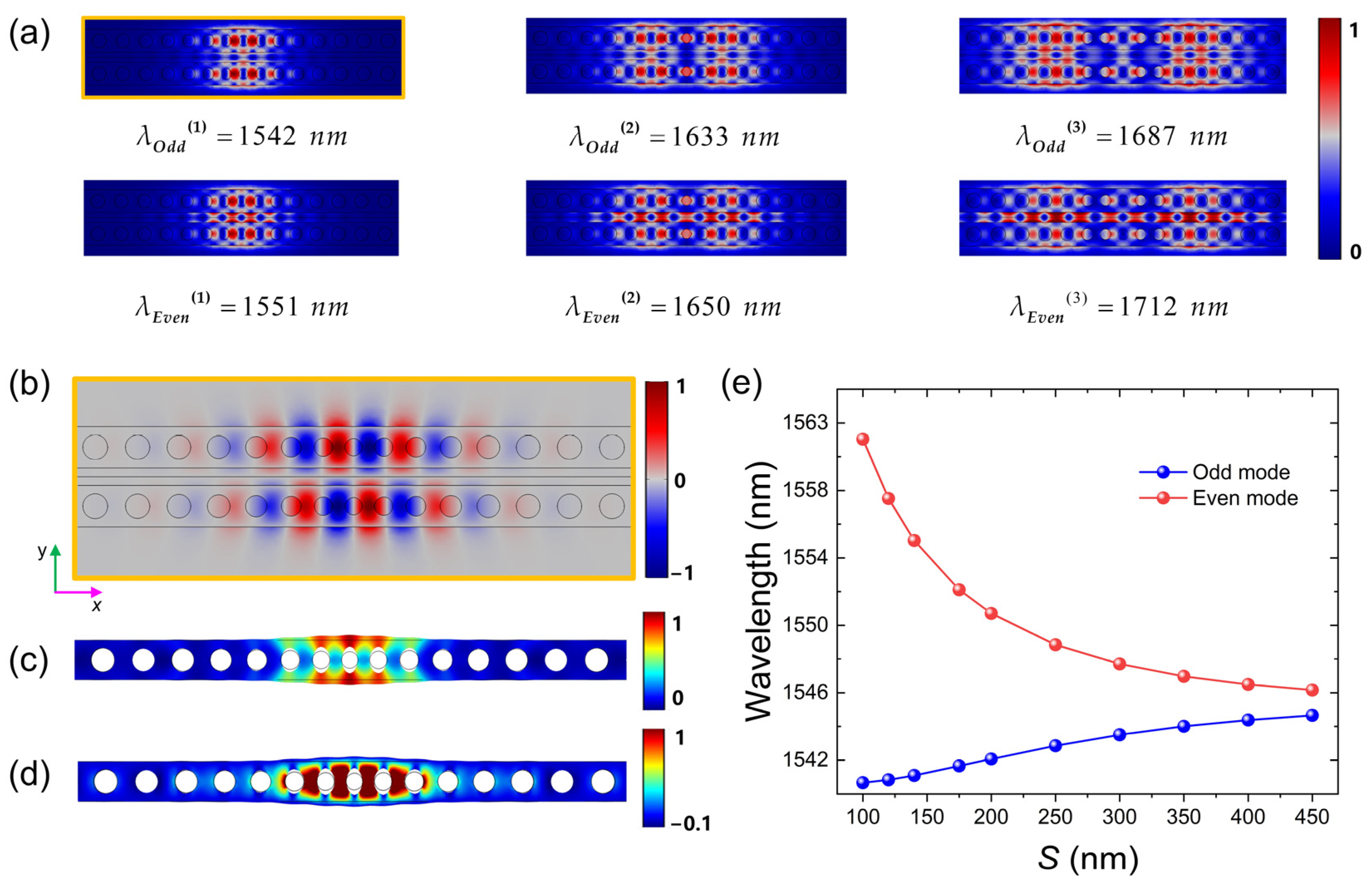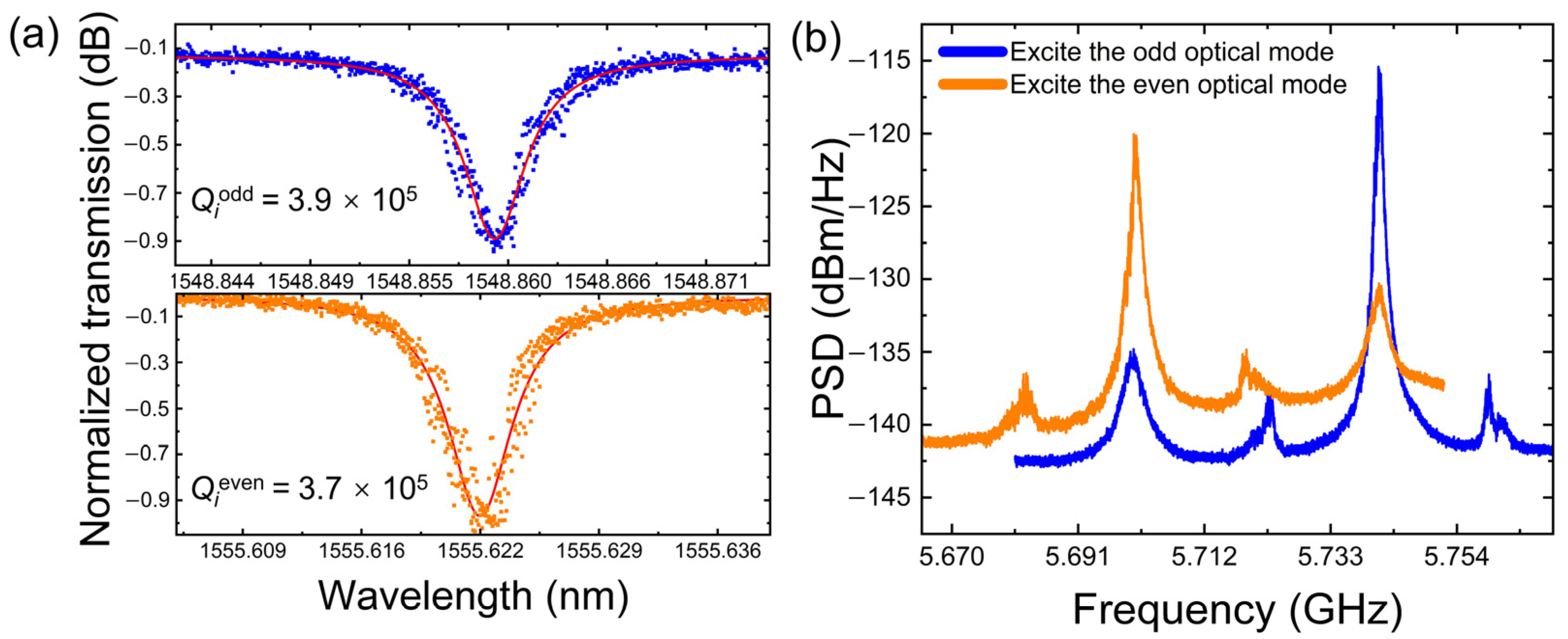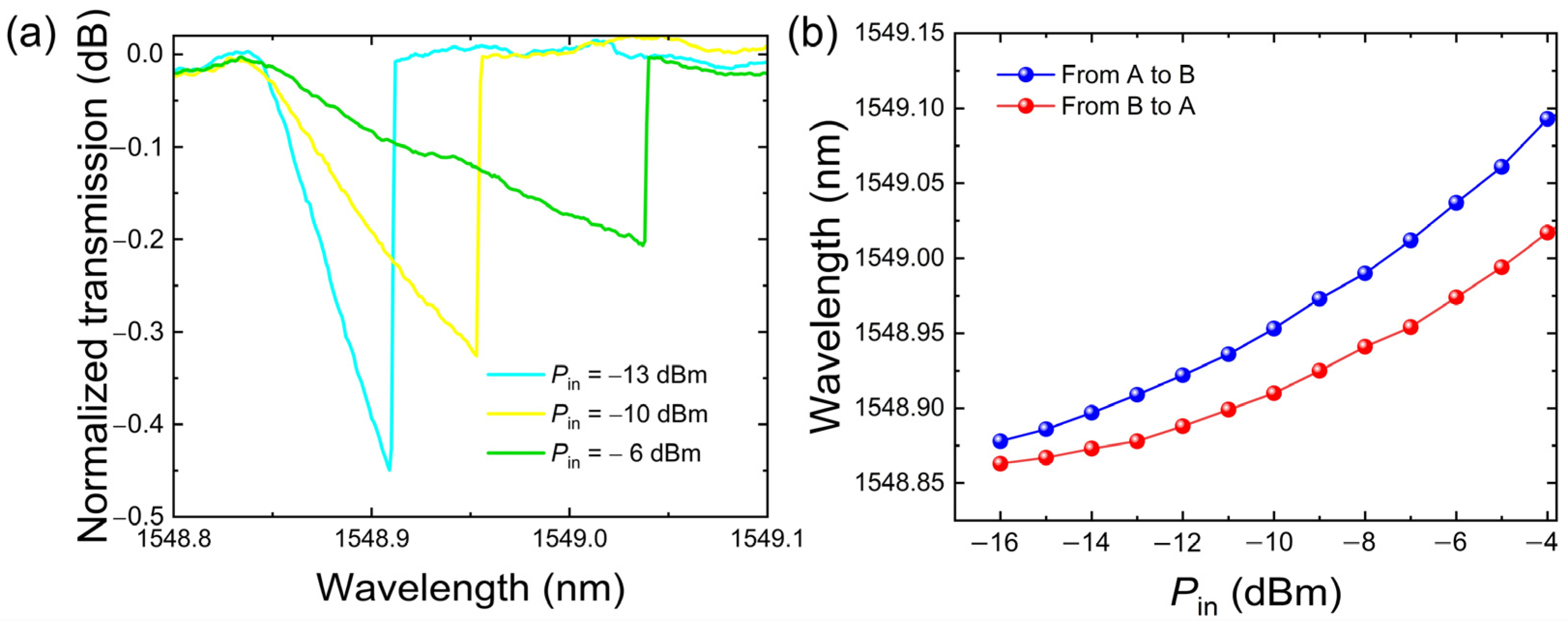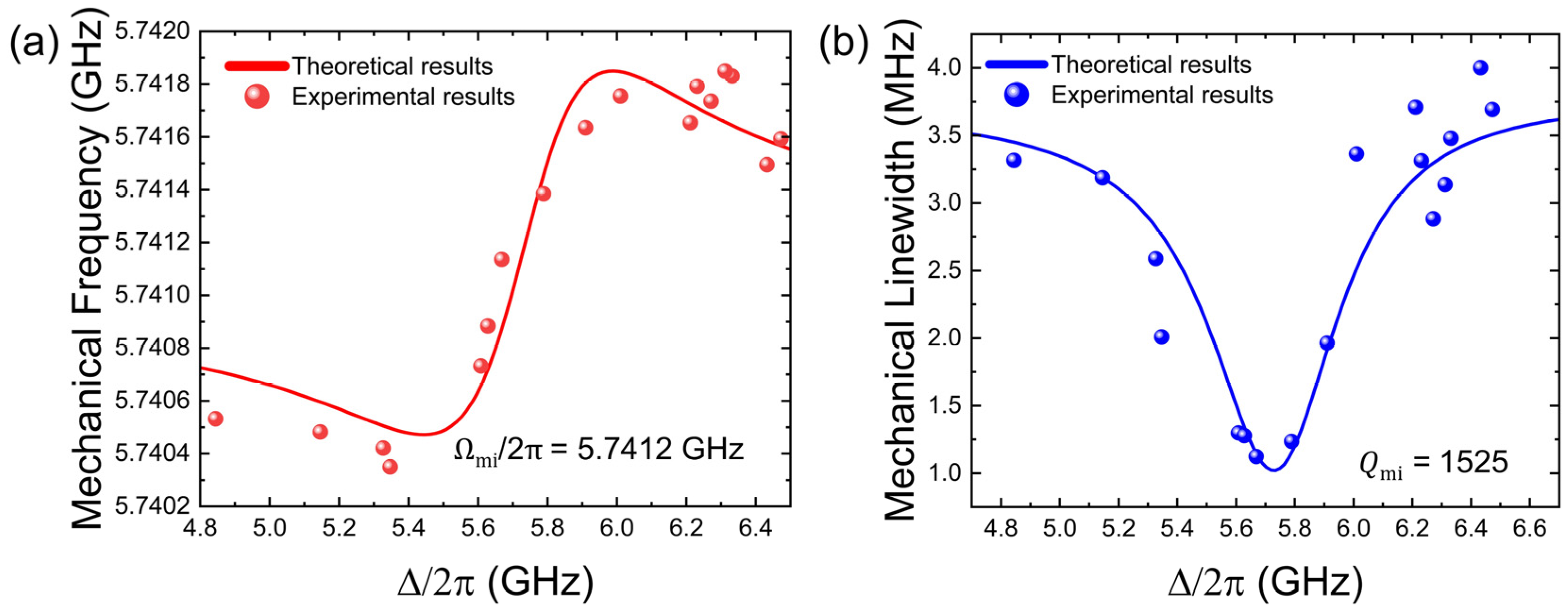Hetero-Optomechanical Crystal Zipper Cavity for Multimode Optomechanics
Abstract
:1. Introduction
2. Methods
2.1. Design of Hetero-OMC Zipper Cavity
2.2. Fabrication and Measurements
3. Results and Discussion
4. Conclusions
Author Contributions
Funding
Institutional Review Board Statement
Informed Consent Statement
Data Availability Statement
Acknowledgments
Conflicts of Interest
References
- Aspelmeyer, M.; Kippenberg, T.J.; Marquardt, F. Cavity Optomechanics. Rev. Mod. Phys. 2014, 86, 1391–1452. [Google Scholar] [CrossRef]
- Kippenberg, T.J.; Vahala, K.J. Cavity Optomechanics: Back-Action at the Mesoscale. Science 2008, 321, 1172–1176. [Google Scholar] [CrossRef] [PubMed] [Green Version]
- Chan, J.; Alegre, T.P.M.; Safavi-Naeini, A.H.; Hill, J.T.; Krause, A.; Gröblacher, S.; Aspelmeyer, M.; Painter, O. Laser Cooling of a Nanomechanical Oscillator into Its Quantum Ground State. Nature 2011, 478, 89–92. [Google Scholar] [CrossRef] [PubMed] [Green Version]
- Delić, U.; Reisenbauer, M.; Dare, K.; Grass, D.; Vuletić, V.; Kiesel, N.; Aspelmeyer, M. Cooling of a Levitated Nanoparticle to the Motional Quantum Ground State. Science 2020, 367, 892–895. [Google Scholar] [CrossRef] [Green Version]
- Safavi-Naeini, A.H.; Alegre, T.P.M.; Chan, J.; Eichenfield, M.; Winger, M.; Lin, Q.; Hill, J.T.; Chang, D.E.; Painter, O. Electromagnetically Induced Transparency and Slow Light with Optomechanics. Nature 2011, 472, 69–73. [Google Scholar] [CrossRef] [Green Version]
- Weis, S.; Rivière, R.; Deléglise, S.; Gavartin, E.; Arcizet, O.; Schliesser, A.; Kippenberg, T.J. Optomechanically Induced Transparency. Science 2010, 330, 1520–1523. [Google Scholar] [CrossRef] [Green Version]
- Gröblacher, S.; Hammerer, K.; Vanner, M.R.; Aspelmeyer, M. Observation of Strong Coupling between a Micromechanical Resonator and an Optical Cavity Field. Nature 2009, 460, 724–727. [Google Scholar] [CrossRef] [Green Version]
- Verhagen, E.; Deléglise, S.; Weis, S.; Schliesser, A.; Kippenberg, T.J. Quantum-Coherent Coupling of a Mechanical Oscillator to an Optical Cavity Mode. Nature 2012, 482, 63–67. [Google Scholar] [CrossRef] [Green Version]
- Krause, A.G.; Winger, M.; Blasius, T.D.; Lin, Q.; Painter, O. A High-Resolution Microchip Optomechanical Accelerometer. Nat. Photonics 2012, 6, 768–772. [Google Scholar] [CrossRef] [Green Version]
- Cui, K.; Huang, Z.; Wu, N.; Xu, Q.; Pan, F.; Xiong, J.; Feng, X.; Liu, F.; Zhang, W.; Huang, Y. Phonon Lasing in a Hetero Optomechanical Crystal Cavity. Photonics Res. 2021, 9, 937. [Google Scholar] [CrossRef]
- Pan, F.; Cui, K.; Bai, G.; Feng, X.; Liu, F.; Zhang, W.; Huang, Y. Radiation-Pressure-Antidamping Enhanced Optomechanical Spring Sensing. ACS Photonics 2018, 5, 4164–4169. [Google Scholar] [CrossRef]
- Li, B.-B.; Bílek, J.; Hoff, U.B.; Madsen, L.S.; Forstner, S.; Prakash, V.; Schäfermeier, C.; Gehring, T.; Bowen, W.P.; Andersen, U.L. Quantum Enhanced Optomechanical Magnetometry. Optica 2018, 5, 850. [Google Scholar] [CrossRef] [Green Version]
- Hill, J.T.; Safavi-Naeini, A.H.; Chan, J.; Painter, O. Coherent Optical Wavelength Conversion via Cavity Optomechanics. Nat. Commun. 2012, 3, 1196. [Google Scholar] [CrossRef] [PubMed] [Green Version]
- Arnold, G.; Wulf, M.; Barzanjeh, S.; Redchenko, E.S.; Rueda, A.; Hease, W.J.; Hassani, F.; Fink, J.M. Converting Microwave and Telecom Photons with a Silicon Photonic Nanomechanical Interface. Nat. Commun. 2020, 11, 4460. [Google Scholar] [CrossRef]
- Colombano, M.F.; Arregui, G.; Capuj, N.E.; Pitanti, A.; Maire, J.; Griol, A.; Garrido, B.; Martinez, A.; Sotomayor-Torres, C.M.; Navarro-Urrios, D. Synchronization of Optomechanical Nanobeams by Mechanical Interaction. Phys. Rev. Lett. 2019, 123, 017402. [Google Scholar] [CrossRef] [Green Version]
- Zhang, M.; Wiederhecker, G.S.; Manipatruni, S.; Barnard, A.; McEuen, P.; Lipson, M. Synchronization of Micromechanical Oscillators Using Light. Phys. Rev. Lett. 2012, 109, 233906. [Google Scholar] [CrossRef] [Green Version]
- Xu, H.; Mason, D.; Jiang, L.; Harris, J.G.E. Topological Energy Transfer in an Optomechanical System with Exceptional Points. Nature 2016, 537, 80–83. [Google Scholar] [CrossRef] [Green Version]
- Xu, Z.; Gao, X.; Bang, J.; Jacob, Z.; Li, T. Non-Reciprocal Energy Transfer through the Casimir Effect. Nat. Nanotechnol. 2021, 1–5. [Google Scholar] [CrossRef]
- Xu, H.; Jiang, L.; Clerk, A.A.; Harris, J.G.E. Nonreciprocal Control and Cooling of Phonon Modes in an Optomechanical System. Nature 2019, 568, 65–69. [Google Scholar] [CrossRef] [Green Version]
- Ockeloen-Korppi, C.F.; Damskägg, E.; Pirkkalainen, J.-M.; Asjad, M.; Clerk, A.A.; Massel, F.; Woolley, M.J.; Sillanpää, M.A. Stabilized Entanglement of Massive Mechanical Oscillators. Nature 2018, 556, 478–482. [Google Scholar] [CrossRef] [Green Version]
- Lin, Q.; Rosenberg, J.; Chang, D.; Camacho, R.; Eichenfield, M.; Vahala, K.J.; Painter, O. Coherent Mixing of Mechanical Excitations in Nano-Optomechanical Structures. Nat. Photonics 2010, 4, 236–242. [Google Scholar] [CrossRef] [Green Version]
- Thompson, J.D.; Zwickl, B.M.; Jayich, A.M.; Marquardt, F.; Girvin, S.M.; Harris, J.G.E. Strong Dispersive Coupling of a High-Finesse Cavity to a Micromechanical Membrane. Nature 2008, 452, 72–75. [Google Scholar] [CrossRef] [PubMed] [Green Version]
- Thijssen, R.; Verhagen, E.; Kippenberg, T.J.; Polman, A. Plasmon Nanomechanical Coupling for Nanoscale Transduction. Nano Lett. 2013, 13, 3293–3297. [Google Scholar] [CrossRef] [PubMed]
- Roxworthy, B.J.; Aksyuk, V.A. Electrically Tunable Plasmomechanical Oscillators for Localized Modulation, Transduction, and Amplification. Optica 2018, 5, 71. [Google Scholar] [CrossRef]
- Koya, A.N.; Cunha, J.; Guerrero-Becerra, K.A.; Garoli, D.; Wang, T.; Juodkazis, S.; Proietti Zaccaria, R. Plasmomechanical Systems: Principles and Applications. Adv. Funct. Mater. 2021, 31, 2103706. [Google Scholar] [CrossRef]
- Asano, M.; Zhang, G.; Tawara, T.; Yamaguchi, H.; Okamoto, H. Near-Field Cavity Optomechanical Coupling in a Compound Semiconductor Nanowire. Commun. Phys. 2020, 3, 230. [Google Scholar] [CrossRef]
- MacCabe, G.S.; Ren, H.; Luo, J.; Cohen, J.D.; Zhou, H.; Sipahigil, A.; Mirhosseini, M.; Painter, O. Nano-Acoustic Resonator with Ultralong Phonon Lifetime. Science 2020, 370, 840–843. [Google Scholar] [CrossRef]
- Huang, Z.; Cui, K.; Li, Y.; Feng, X.; Liu, F.; Zhang, W.; Huang, Y. Strong Optomechanical Coupling in Nanobeam Cavities Based on Hetero Optomechanical Crystals. Sci. Rep. 2015, 5, 15964. [Google Scholar] [CrossRef] [Green Version]
- Li, Y.; Cui, K.; Feng, X.; Huang, Y.; Huang, Z.; Liu, F.; Zhang, W. Optomechanical Crystal Nanobeam Cavity with High Optomechanical Coupling Rate. J. Opt. 2015, 17, 045001. [Google Scholar] [CrossRef]
- Safavi-Naeini, A.H.; Van Thourhout, D.; Baets, R.; Van Laer, R. Controlling Phonons and Photons at the Wavelength-Scale: Silicon Photonics Meets Silicon Phononics. Optica 2019, 6, 213. [Google Scholar] [CrossRef] [Green Version]
- Qi, R.; Xu, Q.; Wu, N.; Cui, K.; Zhang, W.; Huang, Y. Nonsuspended Optomechanical Crystal Cavities Using As2S3 Chalcogenide Glass. Photonics Res. 2021, 9, 893. [Google Scholar] [CrossRef]
- Xiong, H.; Wu, Y. Fundamentals and Applications of Optomechanically Induced Transparency. Appl. Phys. Rev. 2018, 5, 031305. [Google Scholar] [CrossRef]
- Chew, X.; Zhou, G.; Chau, F.S.; Deng, J.; Tang, X.; Loke, Y.C. Dynamic Tuning of an Optical Resonator through MEMS-Driven Coupled Photonic Crystal Nanocavities. Opt. Lett. 2010, 35, 2517. [Google Scholar] [CrossRef] [PubMed]
- Huang, Z.; Cui, K.; Bai, G.; Feng, X.; Liu, F.; Zhang, W.; Huang, Y. High-Mechanical-Frequency Characteristics of Optomechanical Crystal Cavity with Coupling Waveguide. Sci. Rep. 2016, 6, 34160. [Google Scholar] [CrossRef] [PubMed] [Green Version]
- Schliesser, A.; Rivière, R.; Anetsberger, G.; Arcizet, O.; Kippenberg, T.J. Resolved-Sideband Cooling of a Micromechanical Oscillator. Nat. Phys. 2008, 4, 415–419. [Google Scholar] [CrossRef] [Green Version]
- Burek, M.J.; Cohen, J.D.; Meenehan, S.M.; El-Sawah, N.; Chia, C.; Ruelle, T.; Meesala, S.; Rochman, J.; Atikian, H.A.; Markham, M.; et al. Diamond Optomechanical Crystals. Optica 2016, 3, 1404. [Google Scholar] [CrossRef] [Green Version]
- Carmon, T.; Yang, L.; Vahala, K.J. Dynamical Thermal Behavior and Thermal Selfstability of Microcavities. Opt. Express 2004, 12, 9. [Google Scholar] [CrossRef] [Green Version]
- Gorodetsky, M.L.; Schliesser, A.; Anetsberger, G.; Deleglise, S.; Kippenberg, T.J. Determination of the Vacuum Optomechanical Coupling Rate Using Frequency Noise Calibration. Opt. Express 2010, 18, 23236. [Google Scholar] [CrossRef] [Green Version]
- Chan, J.; Safavi-Naeini, A.H.; Hill, J.T.; Meenehan, S.; Painter, O. Optimized Optomechanical Crystal Cavity with Acoustic Radiation Shield. Appl. Phys. Lett. 2012, 101, 081115. [Google Scholar] [CrossRef] [Green Version]
- Deotare, P.B.; McCutcheon, M.W.; Frank, I.W.; Khan, M.; Lončar, M. Coupled Photonic Crystal Nanobeam Cavities. Appl. Phys. Lett. 2009, 95, 031102. [Google Scholar] [CrossRef] [Green Version]
- Safavi-Naeini, A.H.; Gröblacher, S.; Hill, J.T.; Chan, J.; Aspelmeyer, M.; Painter, O. Squeezed Light from a Silicon Micromechanical Resonator. Nature 2013, 500, 185–189. [Google Scholar] [CrossRef] [PubMed] [Green Version]
- Grutter, K.E.; Davanço, M.I.; Srinivasan, K. Slot-Mode Optomechanical Crystals: A Versatile Platform for Multimode Optomechanics. Optica 2015, 2, 994. [Google Scholar] [CrossRef] [PubMed] [Green Version]
- Jing, H.; Özdemir, S.K.; Lü, X.-Y.; Zhang, J.; Yang, L.; Nori, F. PT-Symmetric Phonon Laser. Phys. Rev. Lett. 2014, 113, 053604. [Google Scholar] [CrossRef] [PubMed] [Green Version]
- Zhang, J.; Peng, B.; Özdemir, Ş.K.; Pichler, K.; Krimer, D.O.; Zhao, G.; Nori, F.; Liu, Y.; Rotter, S.; Yang, L. A Phonon Laser Operating at an Exceptional Point. Nat. Photonics 2018, 12, 479–484. [Google Scholar] [CrossRef]
- Qiao, Q.; Xia, J.; Lee, C.; Zhou, G. Applications of Photonic Crystal Nanobeam Cavities for Sensing. Micromachines 2018, 9, 541. [Google Scholar] [CrossRef] [PubMed] [Green Version]






| Qi | g0/2π | Ωmi/2π | Qmi | |
|---|---|---|---|---|
| Present study Silicon hetero-OMC zipper cavity | 0.73 MHz | 5.7412 GHz | (Room temperature) | |
| Ref [39] Silicon single-beam OMC | 1.1 MHz | 5.1 GHz | (6 K) | |
| Ref [40] Silicon optical zipper cavity | – | – | – | |
| Ref [41] Silicon OMC zipper cavity | 0.725 MHz | 28 MHz | (16 K) | |
| Ref [42] Silicon nitride slot mode OMC | 0.32 MHz | 3.49 GHz | (Room temperature) |
Publisher’s Note: MDPI stays neutral with regard to jurisdictional claims in published maps and institutional affiliations. |
© 2022 by the authors. Licensee MDPI, Basel, Switzerland. This article is an open access article distributed under the terms and conditions of the Creative Commons Attribution (CC BY) license (https://creativecommons.org/licenses/by/4.0/).
Share and Cite
Wu, N.; Cui, K.; Feng, X.; Liu, F.; Zhang, W.; Huang, Y. Hetero-Optomechanical Crystal Zipper Cavity for Multimode Optomechanics. Photonics 2022, 9, 78. https://doi.org/10.3390/photonics9020078
Wu N, Cui K, Feng X, Liu F, Zhang W, Huang Y. Hetero-Optomechanical Crystal Zipper Cavity for Multimode Optomechanics. Photonics. 2022; 9(2):78. https://doi.org/10.3390/photonics9020078
Chicago/Turabian StyleWu, Ning, Kaiyu Cui, Xue Feng, Fang Liu, Wei Zhang, and Yidong Huang. 2022. "Hetero-Optomechanical Crystal Zipper Cavity for Multimode Optomechanics" Photonics 9, no. 2: 78. https://doi.org/10.3390/photonics9020078
APA StyleWu, N., Cui, K., Feng, X., Liu, F., Zhang, W., & Huang, Y. (2022). Hetero-Optomechanical Crystal Zipper Cavity for Multimode Optomechanics. Photonics, 9(2), 78. https://doi.org/10.3390/photonics9020078





